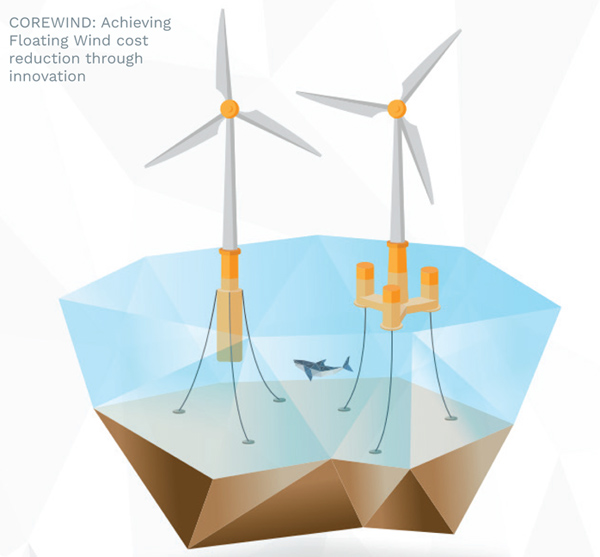Wind Power capacity installations continue growing rapidly. It is clearly seen since in 2016, wind overtook coal as the second power generation capacity in Europe. Additionally, EU plans for energy decarbonisation set a path especially relevant and interesting for offshore wind. In this line, Floating Offshore Wind (FOW) presents a large potential which is unexploited up to now, due to a large amount of wind resource existing in deep waters (<60m).
One of the main drawbacks which is hindering floating offshore wind advent is the cost. Such technology is much more expensive than any existing other (currently, its average LCOE is above 100€/MWh); thus, a reduction of the cost is a need to ensure floating wind technology establishment.
In this regard, COREWIND looks beyond the state of the art of the floating technology with the aim of accelerating the path towards its commercial deployment by developing and validating innovative and cost-effective solutions that allows to solve the most critical barrier of floating offshore wind technology, the cost. The project will achieve at least a 15% LCOE reduction by the end of the project (i.e. 100€/MWh approximately) through disruptive technologies and procedures for floating wind sector; paving the way for achieving future cost objectives earlier (i.e. ≈ 80 €/MWh by 2040, 10 years ahead expectations ).
COREWIND project main objective is to achieve significant cost reductions and enhance performance of floating wind technology by concentrating the research and optimization efforts on two essential components, the mooring and anchoring systems and power dynamic cables. The development of key cost-effective and reliable innovative solutions are applied to two different concretebased floating substructures designs (semi-submersible and spar) supporting very large wind turbines (15 MW). Special focus is given to develop and validate integrated solutions that significantly improve installation techniques and operation and maintenance (O&M) activities. Such innovations aim to not only reduce costs from new concepts but also through technology standardization and market uptake (i.e. the same components may be used under different floater concepts) and digitalization for both better design process and enhanced operation and maintenance. The project is coordinated by the Institut de Recerca en Energia de Catalunya (IREC), in collaboration with key academia as DTU Wind, UPC, POLIMI, University of Stuttgart, IHC and key industrial partners as Innosea, JDR, Ramboll, UL, COBRA, EQUINOR and WindEurope.
COREWIND is a still ongoing project which is already providing value to the fl oating community by leading innovative solutions and making them available as some 15MW floater models (which can be found at the ZENODO page of the project).
The project is working on innovative solutions including the dynamic analysis of shared mooring and anchors, innovative solutions for O&M including vessel analysis and modelling, advanced and coordinated wind farm control and Machine Learning for floating wind turbine monitoring. In addition, lab experimental tests for validation are being performed and an innovative LCOE and LCA evaluation tool (FOWAPP) has been developed.

The COREWIND project has received funding from the European Union's H2020 Programme under Grant Agreement No 815083